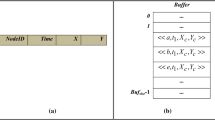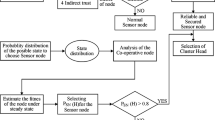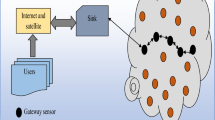Abstract
In recent years, Wireless Sensor Network (WSN) has been used for several applications and various roles like information gathering, monitoring data, transmitting data, etc. However, the key drawback behind this WSN is energy consumption. In WSN, some nodes have been consumed more energy because of malicious events like replication nodes. So, the replication node must be predicted in the initial stage to avoid packet drop and minimize energy consumption. So, this current research proposed a novel Whale-based Node Identity Verification (WbNIV) for detecting replication nodes in the Mobile Wireless Sensor Network. Moreover, the fitness function of the whale is used to identify each node's energy level and for exact replication node detection. Initially, the required numbers of nodes are designed then the details of a node are stored in WbNIV memory. During the monitoring and prediction process, the replication node in the WSN is identified by analyzing the details and behavior of the node. Finally, the proposed WbNIV has gained 98.89% replication node prediction accuracy, recorded the maximum packet drop as 12.8%, and reduced communication delay to 3 s, which is relatively better than the existing models. Thus, it has reduced power consumption up to 30% compared to the existing models. It has also improved the detection accuracy up to 5% than the compared models and has reduced the packet drop up to 10% compared to conventional approaches.












Similar content being viewed by others
Data availability
Data sharing not applicable to this article as no datasets were generated or analysed during the current study.
References
Ayyagari, M. R., Kesswani, N., Kumar, M., & Kumar, K. (2021). Intrusion detection techniques in network environment: A systematic review. Wireless Networks, 27, 1269–1285. https://doi.org/10.1007/s11276-020-02529-3
Hosseini, S. (2020). A new machine learning method consisting of GA-LR and ANN for attack detection. Wireless Networks, 26, 4149–4162. https://doi.org/10.1007/s11276-020-02321-3
Ashraf, U., Khwaja, A., Qadir, J., Avallone, S., & Yuen, C. (2021). WiMesh: Leveraging mesh networking for disaster communication in resource-constrained settings. Wireless Networks, 27, 2785–2812. https://doi.org/10.1007/s11276-021-02621-2
Gheisari, M., Alzubi, J., Zhang, X., Kose, U., & Saucedo, J. A. M. (2020). A new algorithm for optimization of quality of service in peer to peer wireless mesh networks. Wireless Networks, 26, 4965–4973. https://doi.org/10.1007/s11276-019-01982-z
Mehra, P. S., Doja, M. N., & Alam, B. (2020). Fuzzy based enhanced cluster head selection (FBECS) for WSN. Journal of King Saud University-Science, 32(1), 390–401. https://doi.org/10.1016/j.jksus.2018.04.031
Zhang, X., Lu, X., & Zhang, X. (2020). Mobile wireless sensor network lifetime maximization by using evolutionary computing methods. Ad Hoc Networks, 101, 102094. https://doi.org/10.1016/j.adhoc.2020.102094
Kousar, A., Mittal, N., & Singh, P. (2020). An improved hierarchical clustering method for mobile wireless sensor network using type-2 fuzzy logic. Proceedings of ICETIT 2019 (pp. 128–140). Springer, Cham. https://doi.org/10.1007/978-3-030-30577-2_11
Chakraborty, S., Goyal, N. K., Mahapatra, S., & Soh, S. (2020). A Monte-Carlo Markov chain approach for coverage-area reliability of mobile wireless sensor networks with multistate nodes. Reliability Engineering & System Safety, 193, 106662. https://doi.org/10.1016/j.ress.2019.106662
Rajesh, D., & Jaya, T. (2020). A mathematical model for energy efficient secured CH clustering protocol for mobile wireless sensor network. Wireless Personal Communications. https://doi.org/10.1007/s11277-020-07036-4
Mamatha, K. M., & Kiran, M. (2020). A Firefly Optimization Algorithm for Maximizing the Connectivity in Mobile Wireless Sensor Network. Handbook of Wireless Sensor Networks: Issues and Challenges in Current Scenario's (pp. 195–217). Springer, Cham. https://doi.org/10.1007/978-3-030-40305-8_10
Tripathi, Y., Kumar, V., & Prakash, A. (2020). A robust energy-efficient cluster-based routing protocol for mobile wireless sensor network. Advances in VLSI, Communication, and Signal Processing (pp. 61–69). Springer, Singapore. https://doi.org/10.1007/978-981-32-9775-3_6
Chakraborty, S., Goyal, N. K., & Soh, S. (2020). On area coverage reliability of mobile wireless sensor networks with multistate nodes. IEEE Sensors Journal, 20(9), 4992–5003. https://doi.org/10.1109/JSEN.2020.2965592
Thomson, C., Wadhaj, I., Al-Dubai, A., & Tan, Z. (2020). A new mobility aware duty cycling and dynamic preambling algorithm for wireless sensor network. 2020 IEEE 6th World Forum on Internet of Things (WF-IoT), IEEE. https://doi.org/10.1109/WF-IoT48130.2020.9221036
Shobana, M., Sabitha, R., & Karthik, S. (2020). An enhanced soft computing-based formulation for secure data aggregation and efficient data processing in large-scale wireless sensor network. Soft Computing. https://doi.org/10.1007/s00500-020-04694-1
Nayyar, A., & Singh, R. (2015). A comprehensive review of simulation tools for wireless sensor networks (WSNs). Journal of Wireless Networking and Communications, 5(1), 19–47. https://doi.org/10.5923/j.jwnc.20150501.03
Nayyar, A., & Singh, R. (2019). IEEMARP-a novel energy efficient multipath routing protocol based on ant colony optimization (ACO) for dynamic sensor networks. Multimedia Tools and Applications. https://doi.org/10.1007/s11042-019-7627-z
Nayyar, A., Kumar, S., & Nguyen, N. G. (2019). Advances in swarm intelligence and machine learning for optimizing problems in image processing and data analytics (Part 1). Recent Patents on Computer Science, 12(4), 248–249(2). https://doi.org/10.2174/221327591204190517082230
Nayyar, A., Le, D. N., & Nguyen, N. G. (2018). Advances in swarm intelligence for optimizing problems in computer science. CRC Press.
Meng, W., Li, W., Wang, Y., & Au, M. H. (2020). Detecting insider attacks in medical cyber–physical networks based on behavioral profiling. Future Generation Computer Systems, 108, 1258–1266. https://doi.org/10.1016/j.future.2018.06.007
Subashini, S., & Mathiyalagan, P. (2020). A cross layer design and flower pollination optimization algorithm for secured energy efficient framework in wireless sensor network. Wireless Personal Communications. https://doi.org/10.1007/s11277-020-07118-3
Mathapati, M., Kumaran, T. S., Patil, K. K., Patil, S. S., & Veena, H. N. (2020). A study on secure data aggregation and routing for wireless sensor networks. In: International conference on advanced informatics for computing research, Springer, Singapore. https://doi.org/10.1007/978-981-16-3653-0_14
Dimitriou, T., Alrashed, E. A., Karaata, M. H., & Hamdan, A. (2016). Imposter detection for replication attacks in mobile sensor networks. Computer Networks, 108, 210–222. https://doi.org/10.1016/j.comnet.2016.08.019
Shaukat, H. R., Hashim, F., Shaukat, M. A., & Ali Alezabi, K. (2020). Hybrid multi-level detection and mitigation of clone attacks in mobile wireless sensor network (MWSN). Sensors, 20(8), 2283. https://doi.org/10.3390/s20082283
Alrashed, E. A., Karaata, M. H., Hamdan, A., & Albahar, B. (2017). An adaptive stabilizing imposter detection scheme for distributed mobile wireless sensor networks. Ad Hoc Networks, 65, 1–12. https://doi.org/10.1016/j.adhoc.2017.07.003
Faisal, M., Abbas, S., & Rahman, H. U. (2018). Identity attack detection system for 802.11-based ad hoc networks. EURASIP Journal on Wireless Communications and Networking, 2018(1), 1–16. https://doi.org/10.1186/s13638-018-1143-0
Jeyakumar, D. J., & Lingeshwari, S. (2020). Fake sensor detection and secure data transmission based on predictive parser in WSNs. Wireless Personal Communications, 110(1), 531–544. https://doi.org/10.1007/s11277-019-06740-0
Singh, A., & Gupta, K. (2018). Preventing node replication attack in mobile wireless sensor networks. Information and Communication Technology for Sustainable Development (pp. 311–317). Springer, Singapore. https://doi.org/10.1007/978-981-10-3932-4_32
Anitha, S., Jayanthi, P., & Thangarajan, R. (2020). Detection of replica node attack based on exponential moving average model in wireless sensor networks. Wireless Personal Communications, 115(2), 1651–1666. https://doi.org/10.1007/s11277-020-07648-w
Mariappan, S. M., & Selvakumar, S. (2021). A novel location pinpointed anti-jammer with knowledged estimated localizer for secured data transmission in mobile wireless sensor network. Wireless Personal Communications, 118(4), 2073–2094. https://doi.org/10.1007/s11277-020-07885-z
Deng, X. M., & Xiong, Y. (2011). A new protocol for the detection of node replication attacks in mobile wireless sensor networks. Journal of Computer Science and Technology, 26(4), 732–743. https://doi.org/10.1007/s11390-011-1172-1
Rajandekar, A., & Sikdar, B. (2015). A survey of MAC layer issues and protocols for machine-to-machine communications. IEEE Internet of Things Journal, 2(2), 175–186. https://doi.org/10.1109/JIOT.2015.2394438
Da Silva, C. A. G., & Pedroso, C. M. (2019). Mac-layer packet loss models for wi-fi networks: A survey. IEEE Access, 7, 180512–180531. https://doi.org/10.1109/ACCESS.2019.2958260
Wang, G., & Qin, Y. (2019). MAC protocols for wireless mesh networks with multi-beam antennas: A survey. Future of Information and Communication Conference. Springer, Cham. https://doi.org/10.1007/978-3-030-12388-8_9
Manesh, M. R., & Kaabouch, N. (2018). Security threats and countermeasures of MAC layer in cognitive radio networks. Ad Hoc Networks, 70, 85–102. https://doi.org/10.1016/j.adhoc.2017.11.003
Hamza, T., Kaddoum, G., Meddeb, A., & Matar, G. (2016). A survey on intelligent MAC layer jamming attacks and countermeasures in WSNs. 2016 IEEE 84th Vehicular Technology Conference (VTC-Fall), IEEE. https://doi.org/10.1109/VTCFall.2016.7880885
Anitha, S., Jayanthi, P., & Chandrasekaran, V. (2021). An intelligent based healthcare security monitoring schemes for detection of node replication attack in wireless sensor networks. Measurement, 167, 108272. https://doi.org/10.1016/j.measurement.2020.108272
Devi, P. P., & Jaison, B. (2020). Protection on wireless sensor network from clone attack using the SDN-enabled hybrid clone node detection mechanisms. Computer Communications, 152, 316–322. https://doi.org/10.1016/j.comcom.2020.01.064
Jamshidi, M., Esnaashari, M., Darwesh, A. M., & Meybodi, M. R. (2020). Using time-location tags and watchdog nodes to defend against node replication attack in mobile wireless sensor networks. International Journal of Wireless Information Networks, 27(1), 102–115. https://doi.org/10.1007/s10776-019-00469-0
Li, L., Xu, G., Jiao, L., Li, X., Wang, H., Hu, J., Xian, H., Lian, W., & Gao, H. (2019). A secure random key distribution scheme against node replication attacks in industrial wireless sensor systems. IEEE Transactions on Industrial Informatics, 16(3), 2091–2101. https://doi.org/10.1109/TII.2019.2927296
Sujihelen, L., & Jayakumar, C. (2018). Inclusive elliptical curve cryptography (IECC) for wireless sensor network efficient operations. Wireless Personal Communications, 99(2), 893–914. https://doi.org/10.1007/s11277-017-5157-4
Agrawal, S., Das, M. L., & Lopez, J. (2018). Detection of node capture attack in wireless sensor networks. IEEE Systems Journal, 13(1), 238–247. https://doi.org/10.1109/JSYST.2018.2863229
Jamshidi, M., Poor, S. S. A., Arghavani, A., Esnaashari, M., Shaltooki, A. A., & Meybodi, M. R. (2020). A simple, lightweight, and precise algorithm to defend against replica node attacks in mobile wireless networks using neighboring information. Ad Hoc Networks, 100, 102081. https://doi.org/10.1016/j.adhoc.2020.102081
Mbarek, B., Ge, M., & Pitner, T. (2021). Proactive trust classification for detection of replication attacks in 6LoWPAN-based IoT. Internet of Things, 16, 100442. https://doi.org/10.1016/j.iot.2021.100442
Amudha, G., & Narayanasamy, P. (2018). Distributed location and trust based replica detection in wireless sensor networks. Wireless Personal Communications, 102(4), 3303–3321. https://doi.org/10.1007/s11277-018-5369-2
Kumar, D. R., & Shanmugam, A. (2018). A hyper heuristic localization based cloned node detection technique using GSA based simulated annealing in sensor networks. Cognitive computing for big data systems over IoT (pp. 307–335). Springer, Cham. https://doi.org/10.1007/978-3-319-70688-7_13
Acknowledgements
None
Author information
Authors and Affiliations
Corresponding author
Ethics declarations
Conflict of interest
The authors declare that they have no potential conflict of interest.
Ethical approval
All applicable institutional and/or national guidelines for the care and use of animals were followed.
Informed consent
For this type of study formal consent is not required.
Additional information
Publisher's Note
Springer Nature remains neutral with regard to jurisdictional claims in published maps and institutional affiliations.
Rights and permissions
About this article
Cite this article
Sajitha, M., Kavitha, D. & Reddy, P.C. An optimized whale based replication node prediction in wireless sensor network. Wireless Netw 28, 1587–1603 (2022). https://doi.org/10.1007/s11276-022-02928-8
Published:
Issue Date:
DOI: https://doi.org/10.1007/s11276-022-02928-8




